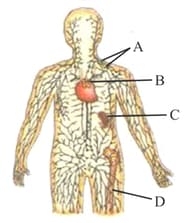The fluid which is present outside the cell in interstitial space forms due to
Important Questions on Body Fluids and Circulation
Statement II: The thymus gland of mammals is a secondary lymphoid organ.

Read the following statements and identify if they are true (T) or false (F):
(i) Booster response is also called 'anamnestic response'.
(ii) Allergy is due to release of chemicals like histamine and serotonin from mast cells.
(iii) Modern day lifestyle has resulted in lowering of immunity and more sensitivity to allergens.
(iv) Primary lymphoid organs provide the sites for interaction of lymphocytes with the antigen, which then proliferate to become effector cells.
(v) Passive immunity is slow and takes time to give its full effective response.
| (i) | (ii) | (iii) | (iv) | (v) | |
| (1) | T | T | T | F | F |
| (2) | T | T | F | T | F |
| (3) | F | F | T | F | F |
| (4) | F | T | F | T | F |
Assertion: Lymph in lymphatic system is known as tissue fluid.
Reason: It consists of plasma proteins, RBCs and WBCs.
Read the following statement:
(i) The spleen is a large reservoir of RBCs.
(ii) Lymph nodes serve to trap the microorganisms which happen to get into the lymph and tissue fluid.
(iii) Mucosa Associated Lymphoid Tissue (MALT) constitutes 50% of the lymphoid tissue in the human body.
(iv) Thymus acts as a filter of blood by trapping blood-borne microorganisms.
(v) Only thymus provides a microenvironment for development and maturation of T lymphocytes.
Which of the above statements are correct?
Identify the incorrect statements from the ones given below:
(i) Peyer’s patches are also called 'abdominal tonsils'.
(ii) Immunoglobulins are chemically lipoproteins.
(iii) Spleen is a large bean-shaped organ which mainly contains lymphocytes and phagocytes.
(iv) All lymphocytes are phagocytic and engulf pathogens.
The important function of the spleen is/are:

